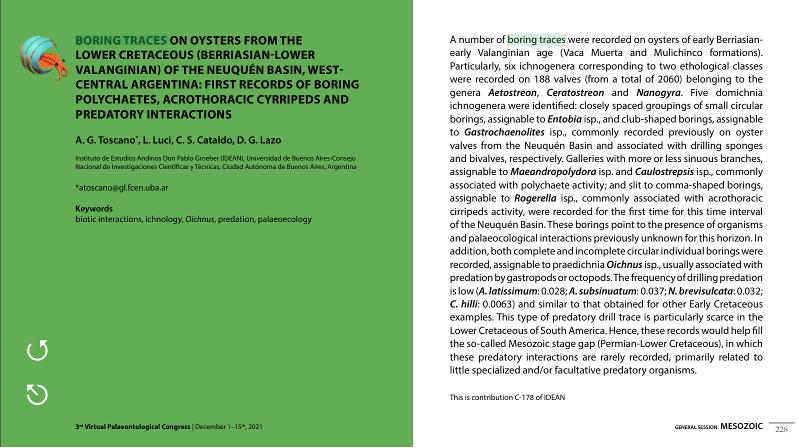Evento
Boring traces on oysters from the Lower Cretaceous (Berriasian-Lower Valanginian) of the Neuquén Basin, Westcentral Argentina: first records of boring polychaetes, acrothoracic cyrripeds and predatory interactions
Tipo del evento:
Congreso
Nombre del evento:
3rd Palaeontological Virtual Congress
Fecha del evento:
01/12/2021
Institución Organizadora:
Palaeontological Association;
Título del Libro:
3rd Palaeontological Virtual Congress: Book of abstracts
Editorial:
Palaeontological Association
ISBN:
978-84-09-36657-6
Idioma:
Inglés
Clasificación temática:
Resumen
A number of boring traces were recorded on oysters of early Berriasianearly Valanginian age (Vaca Muerta and Mulichinco formations). Particularly, six ichnogenera corresponding to two ethological classes were recorded on 188 valves (from a total of 2060) belonging to the genera Aetostreon, Ceratostreon and Nanogyra. Five domichnia ichnogenera were identified: closely spaced groupings of small circular borings, assignable to Entobia isp., and club-shaped borings, assignable to Gastrochaenolites isp., commonly recorded previously on oyster valves from the Neuquén Basin and associated with drilling sponges and bivalves, respectively. Galleries with more or less sinuous branches, assignable to Maeandropolydora isp. and Caulostrepsis isp., commonly associated with polychaete activity; and slit to comma-shaped borings, assignable to Rogerella isp., commonly associated with acrothoracic cirripeds activity, were recorded for the first time for this time intervalof the Neuquén Basin. These borings point to the presence of organisms and palaeocological interactions previously unknown for this horizon. In addition, both complete and incomplete circular individual borings were recorded, assignable to praedichnia Oichnus isp., usually associated withpredation by gastropods or octopods. The frequency of drilling predation is low (A. latissimum: 0.028; A. subsinuatum: 0.037; N. brevisulcata: 0.032; C. hilli: 0.0063) and similar to that obtained for other Early Cretaceous examples. This type of predatory drill trace is particularly scarce in theLower Cretaceous of South America. Hence, these records would help fill the so-called Mesozoic stage gap (Permian-Lower Cretaceous), in which these predatory interactions are rarely recorded, primarily related to little specialized and/or facultative predatory organisms.
Palabras clave:
Boring traces
,
Oysters
,
Cretaceous
,
Nequén Basin
Archivos asociados
Licencia
Identificadores
Colecciones
Eventos(IDEAN)
Eventos de INSTITUTO DE ESTUDIOS ANDINOS "DON PABLO GROEBER"
Eventos de INSTITUTO DE ESTUDIOS ANDINOS "DON PABLO GROEBER"
Citación
Boring traces on oysters from the Lower Cretaceous (Berriasian-Lower Valanginian) of the Neuquén Basin, Westcentral Argentina: first records of boring polychaetes, acrothoracic cyrripeds and predatory interactions; 3rd Palaeontological Virtual Congress; Argentina; 2021; 1-1
Compartir




